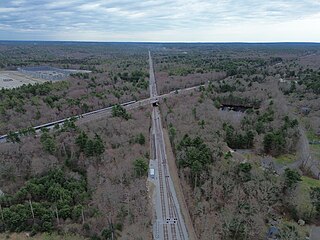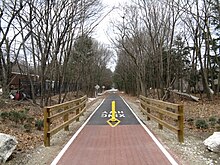
The New York, New Haven and Hartford Railroad, commonly known as The Consolidated, or simply as the New Haven, was a railroad that operated principally in the New England region of the United States from 1872 to December 31, 1968. Founded by the merger of the New York and New Haven and Hartford and New Haven railroads, the company had near-total dominance of railroad traffic in Southern New England for the first half of the 20th century.

The MBTA Commuter Rail system serves as the commuter rail arm of the Massachusetts Bay Transportation Authority's (MBTA's) transportation coverage of Greater Boston in the United States. Trains run over 394 mi (634 km) of track to 135 stations. It is operated under contract by Keolis, which took over operations on July 1, 2014, from the Massachusetts Bay Commuter Railroad Company (MBCR).

The Boston and Albany Railroad was a railroad connecting Boston, Massachusetts to Albany, New York, later becoming part of the New York Central Railroad system, Conrail, and CSX Transportation. The mainline is currently used by CSX for freight as the Berkshire Subdivision and Boston Subdivision. Passenger service is provided on the line by Amtrak, as part of their Lake Shore Limited service, and by the MBTA Commuter Rail system, which owns the section east of Worcester and operates it as its Framingham/Worcester Line.

The Old Colony Railroad (OC) was a major railroad system, mainly covering southeastern Massachusetts and parts of Rhode Island, which operated from 1845 to 1893. Old Colony trains ran from Boston to points such as Plymouth, Fall River, New Bedford, Newport, Providence, Fitchburg, Lowell and Cape Cod. For many years the Old Colony Railroad Company also operated steamboat and ferry lines, including those of the Fall River Line with express train service from Boston to its wharf in Fall River where passengers boarded luxury liners to New York City. The company also briefly operated a railroad line on Martha's Vineyard, as well as the freight-only Union Freight Railroad in Boston. The OC was named after the "Old Colony", the nickname for the Plymouth Colony.
The Fall River Secondary is a freight railroad line in the U.S. state of Massachusetts, owned by the Massachusetts Bay Transportation Authority, with freight operations handled by the Massachusetts Coastal Railroad; it was formerly owned and operated by CSX Transportation. The line runs from the New Bedford Subdivision at Myricks south to Fall River along a former New York, New Haven and Hartford Railroad line. At its south end, at the Rhode Island state line in Fall River, it becomes a line of the Providence and Worcester Railroad.

The New Bedford Main Line, also known as the New Bedford Subdivision, is a freight railroad line in the U.S. state of Massachusetts owned by the Massachusetts Bay Transit Authority, with freight operations handled by the Massachusetts Coastal Railroad. The line runs from Cotley Junction where it meets the Middleboro Secondary near Weir Village south to New Bedford along a former New York, New Haven and Hartford Railroad line. The Fall River Secondary branches off at Myricks Junction.

The Middleboro Secondary is a railroad line owned by MassDOT in the U.S. state of Massachusetts. The line runs from Attleboro to Middleborough via Taunton.

The Framingham Secondary is a railroad line in the U.S. state of Massachusetts. The line runs from Mansfield northwest to Framingham along a former New York, New Haven and Hartford Railroad line. Its south end is at Amtrak's Northeast Corridor, over which CSX has trackage rights to reach the Middleboro Subdivision at Attleboro and the Boston Subdivision in Boston. Its north end is at the Framingham/Worcester Line; the Fitchburg Secondary continues northwest from Framingham.

The Fitchburg Subdivision is a railroad line owned by CSX Transportation in the U.S. state of Massachusetts. The line runs from Fitchburg southeast to Framingham Center along a former New York, New Haven and Hartford Railroad line. Its south end is at the Boston Subdivision; the MBTA's Framingham Secondary continues southeast from Framingham.
The Fairhaven Branch Railroad was a short-line railroad in Massachusetts. It ran from West Wareham on the Cape Cod main line of the Old Colony Railroad, southwest to Fairhaven, a town across the Acushnet River from New Bedford.

Mansfield station is an MBTA Commuter Rail station in Mansfield, Massachusetts. Located in downtown Mansfield, it serves the Providence/Stoughton Line. With 1,966 weekday boardings in a 2018 count, Mansfield is the third-busiest station on the system outside Boston.

The Taunton Branch Railroad was one of the earliest railroads to be established in Massachusetts, United States. It was chartered by the state in 1835 as a branch of the Boston and Providence Railroad running between Mansfield and Taunton, Massachusetts. The railroad provided a rapid overland connection between the seat of Bristol County and Boston and Providence.
The Dighton and Somerset Railroad, currently referred to as the Dean Street Industrial Track, is a railroad that ran between Fall River and Braintree, Massachusetts. It opened in 1866; from the 1890s to the 1930s and again in the late 1950s, it was the primary rail route from Boston to the South Coast. Passenger service ended in stages with the final regular service in 1958, though freight service on two short segments continues into the 21st century. MBTA Commuter Rail service is proposed to be extended onto the northern part of the line around 2030 as part of the South Coast Rail project.

The Fitchburg and Worcester Railroad was a railroad in Massachusetts. It was incorporated in 1840 to provide a rail connection between Fitchburg and Worcester. Service began on February 11, 1850, running 18 miles from Fitchburg through Leominster and Sterling to Sterling Junction, where it connected with the Worcester and Nashua Railroad.

The Agricultural Branch Railroad was a railroad in Massachusetts. It was incorporated by the Legislature of Massachusetts on April 26, 1847, to provide a rail connection between Framingham and Northborough through the town of Southborough and a small portion of the city of Marlborough. Service began on December 1, 1855.
The New Bedford Railroad was a railroad in Massachusetts. It was incorporated on July 1, 1873, as a merger between the New Bedford and Taunton Railroad, the Taunton Branch Railroad, and the Middleborough and Taunton Railroad. The main line ran from a junction with the Boston and Providence Railroad in Mansfield through the towns of Norton, Taunton, Berkley, Lakeville, and Freetown to the deep-water whaling port of New Bedford. The railroad also had several branches, including the former Middleborough and Taunton Railroad, which ran from Weir Village, Taunton into Middleborough through Raynham, and a shortcut to Providence via the Boston and Providence Railroad which ran from Taunton to Attleborough through Norton.

The Framingham and Lowell Railroad was a railroad in Middlesex County, Massachusetts. It was incorporated in 1870 to provide a rail connection between the growing railroad hub of Framingham and the important mill city of Lowell, passing through the towns of Sudbury, Concord, Acton, Carlisle, Westford and Chelmsford. The 26.1 mile line opened on October 1, 1871.
The Taunton and Middleborough Railroad was a railroad in Massachusetts. It was incorporated in 1848 to connect the Taunton Branch Railroad in Weir Village, Taunton with the Fall River Railroad and newly built Cape Cod Branch Railroad in Middleborough through the town of Raynham. In 1853, the railroad changed its name to the Middleborough and Taunton Railroad.
The Charles River Railroad was a railroad in the U.S. state of Massachusetts. It ran from a connection with the end of the Charles River Branch Railroad in Dover to Bellingham through the current-day towns of Medfield, Millis, and Medway.
















